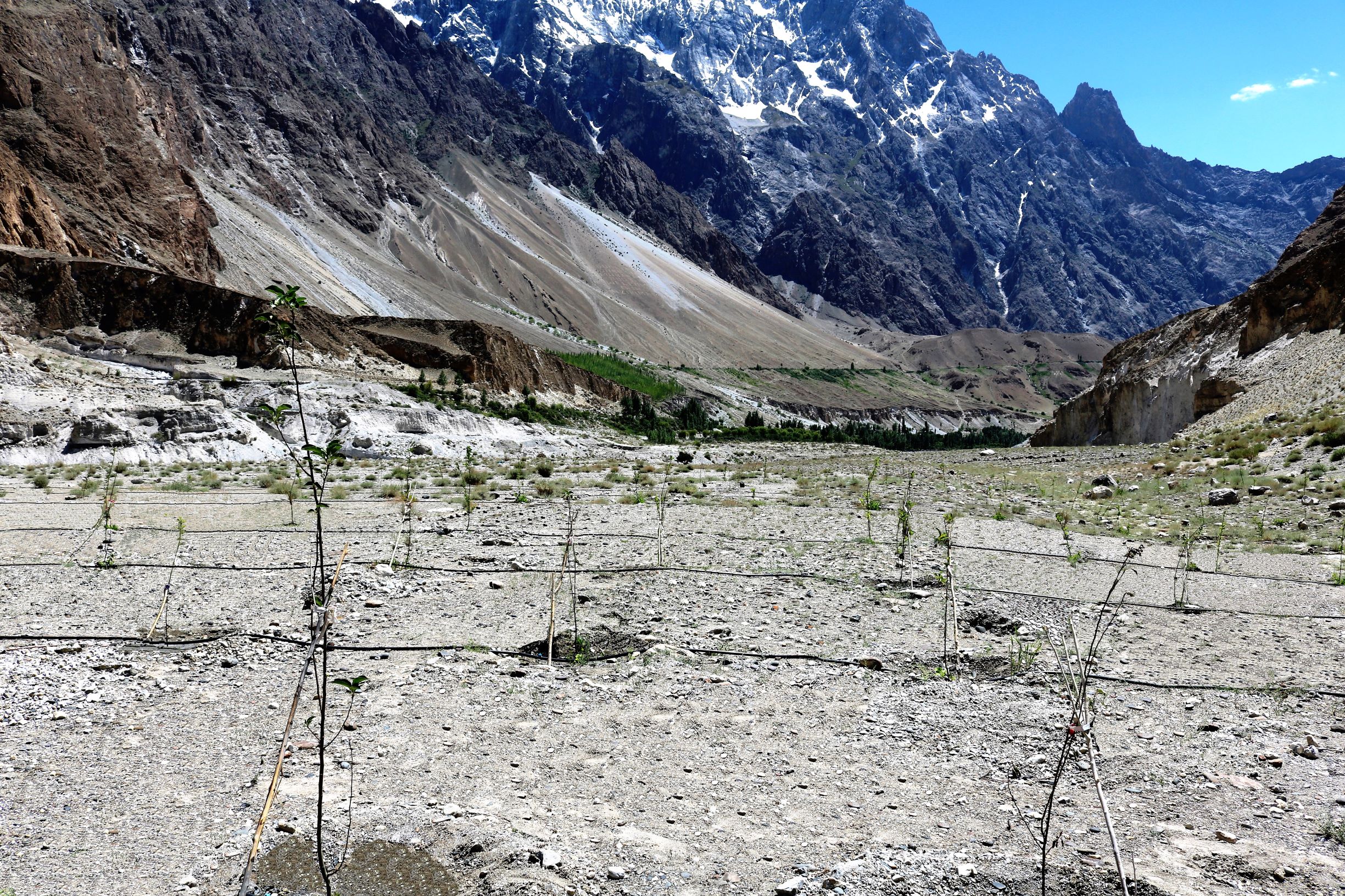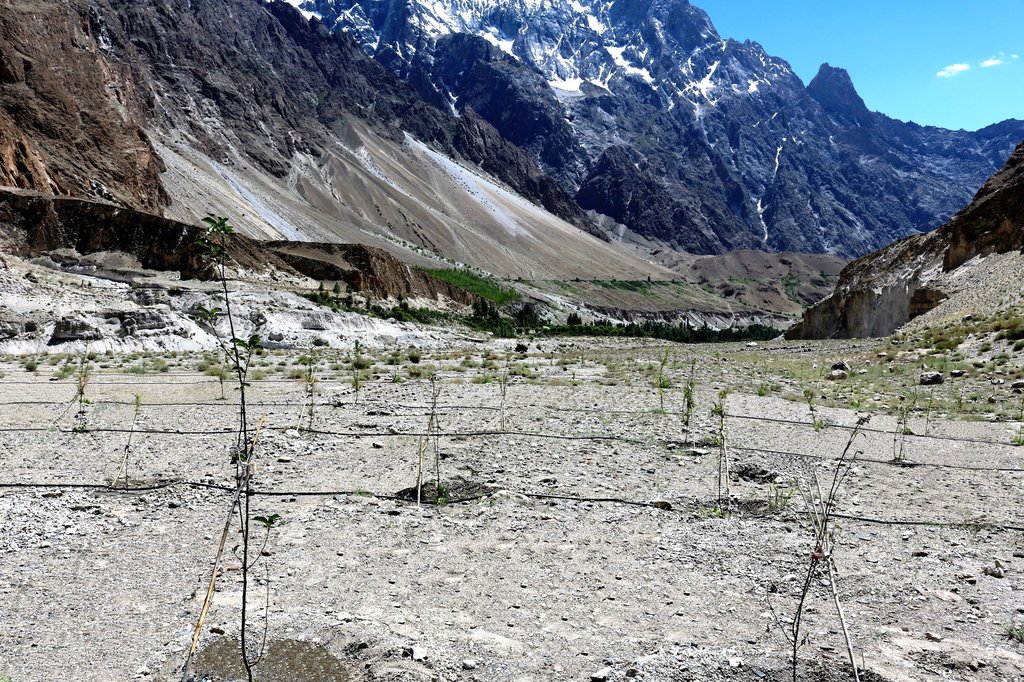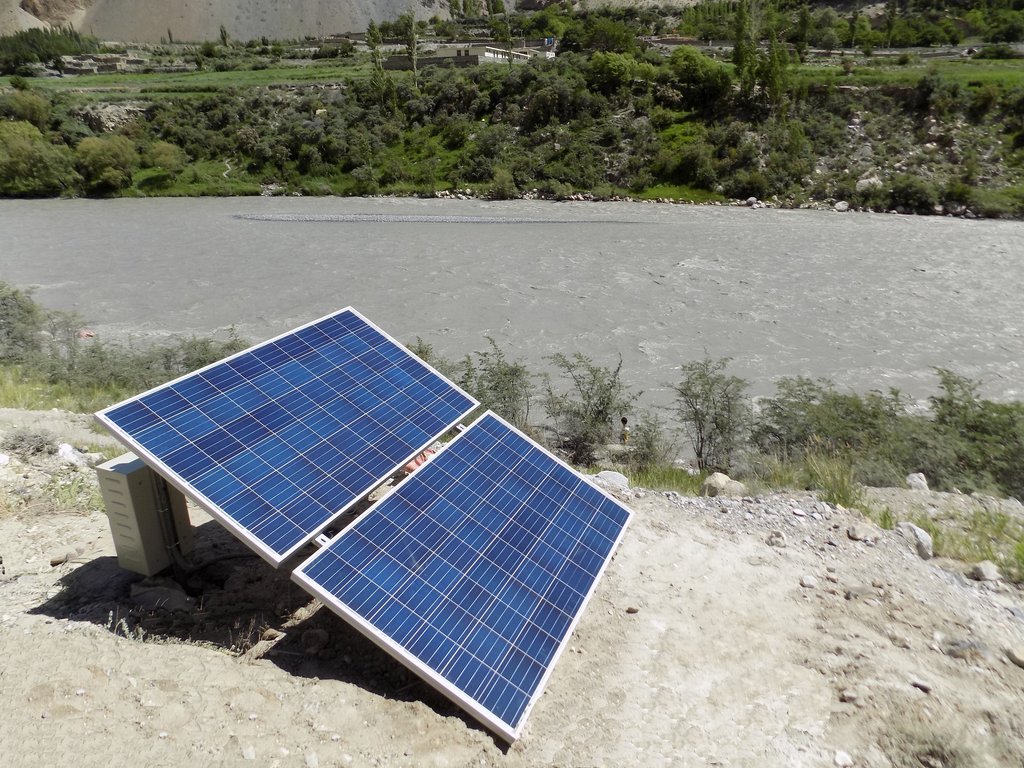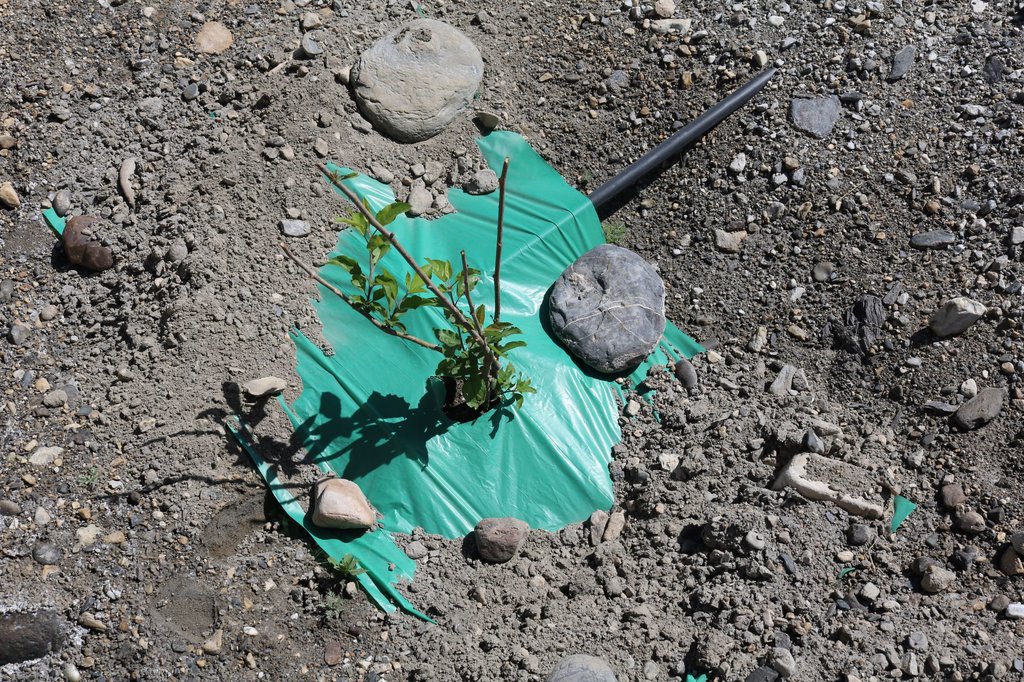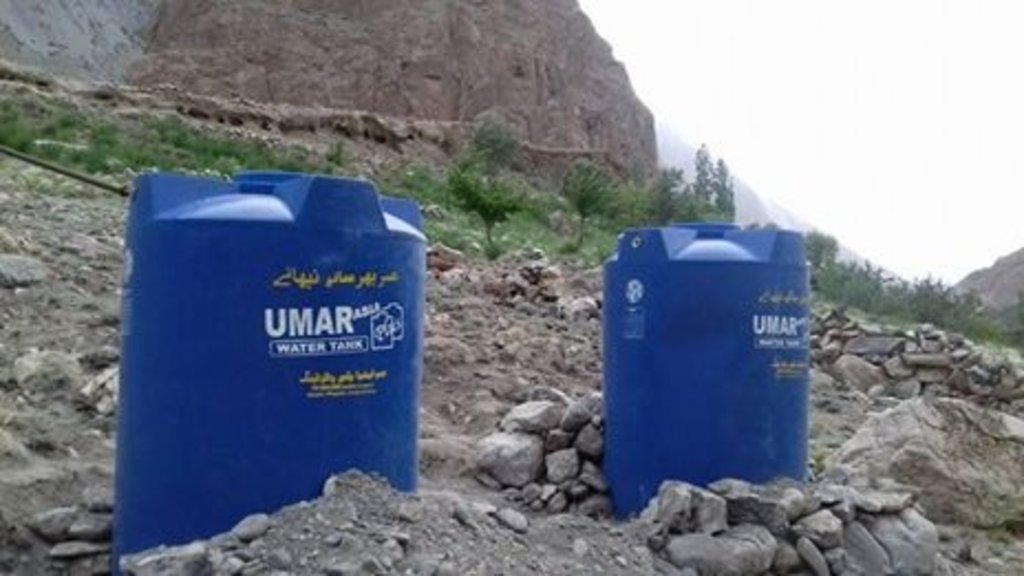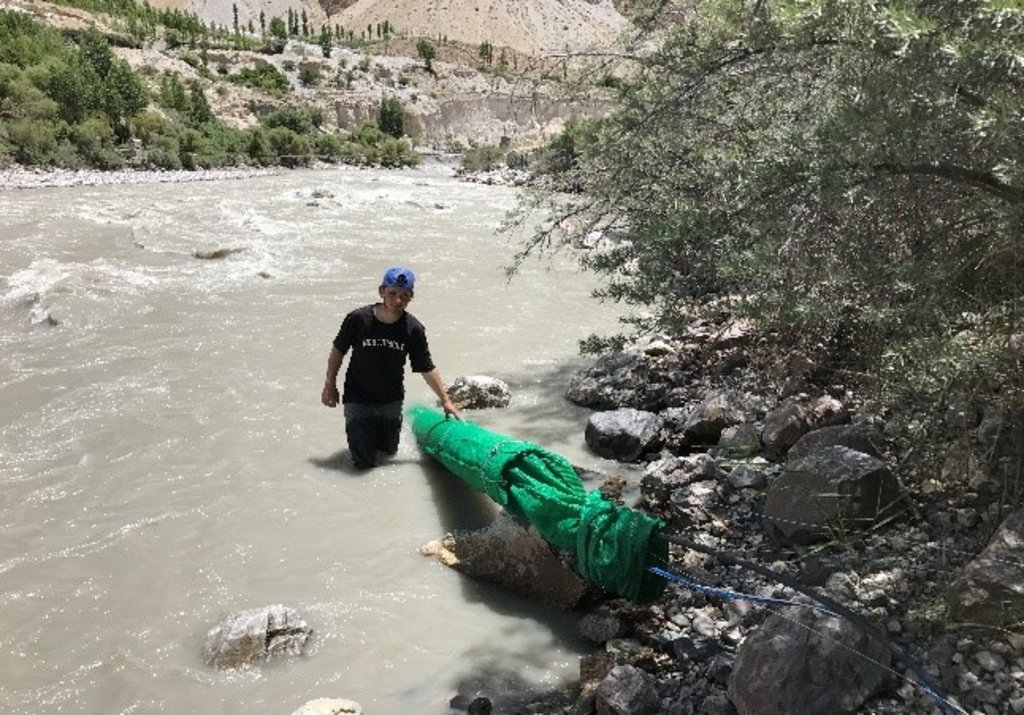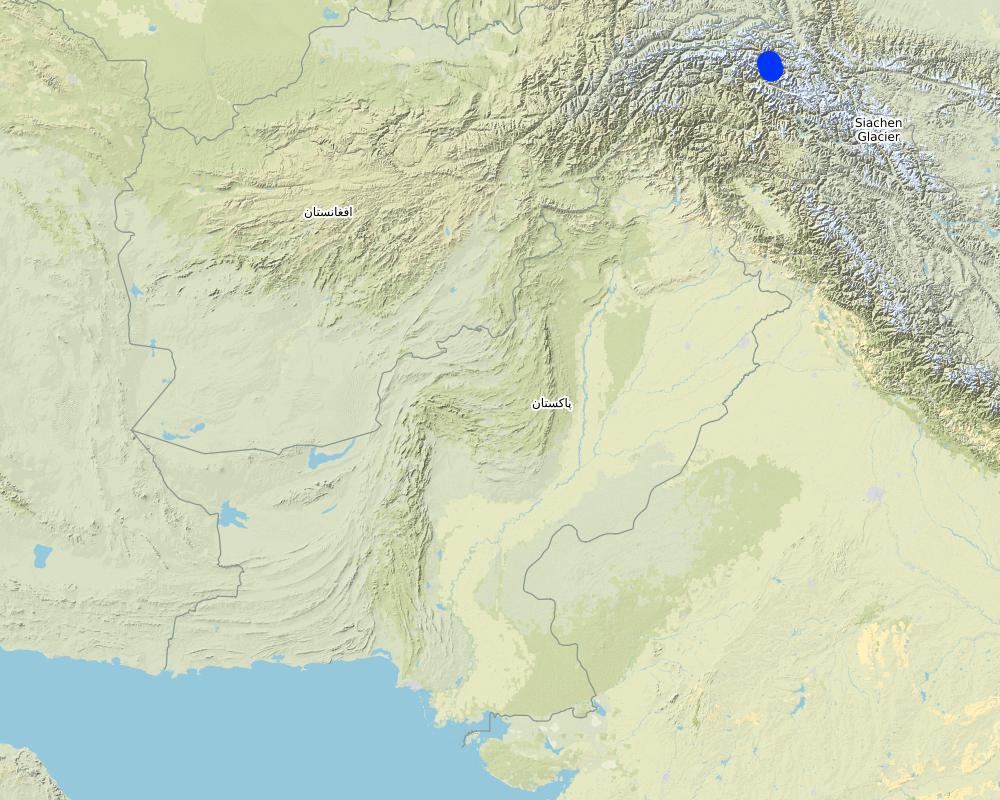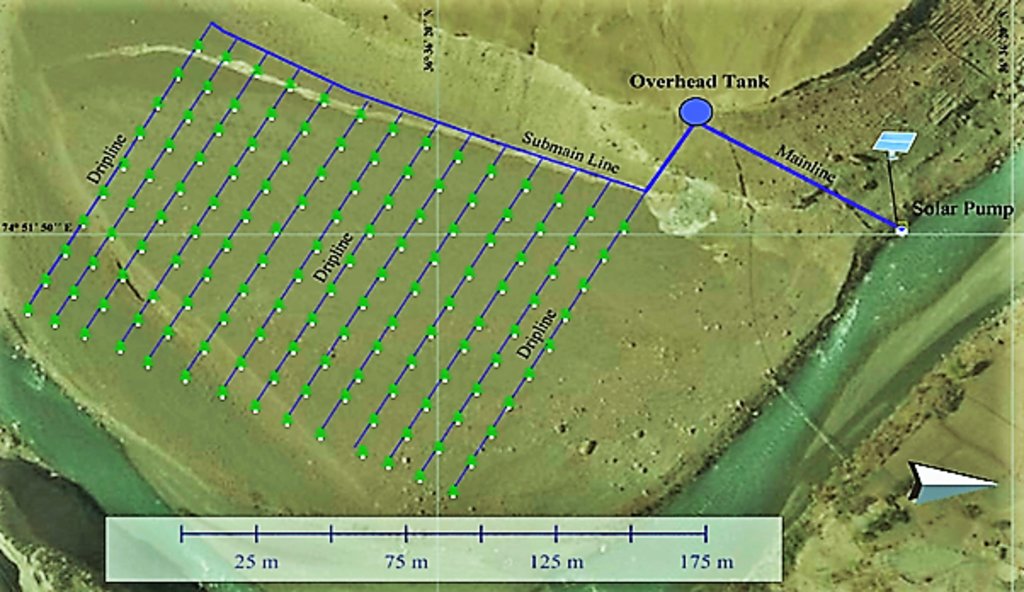Solar Power Water Lifting and Application to Orchard through Drip Irrigation [Пакистан]
- Создание:
- Обновить:
- Составитель: Madhav Dhakal
- Редактор: –
- Рецензент: Rima Mekdaschi Studer
technologies_5610 - Пакистан
Просмотреть разделы
Развернуть все Свернуть все1. Общая информация
1.2 Контактные данные специалистов и организаций, участвующих в описании и оценке Технологии
Ответственный (-ые) специалист (-ы)
Специалист по УЗП:
Maqsood Muhammad Mudassar
International Centre for Integrated Mountain Development
Пакистан
Специалист по УЗП:
Shah Ghulam Muhammad
International Centre for Integrated Mountain Development
Пакистан
Специалист по УЗП:
Bhatti Ahmad Zeeshan
Pakistan Council of Research in Water Resources
Пакистан
Специалист по УЗП:
Khan Muhammad Zafar
Karakorum International University
Пакистан
Специалист по УЗП:
Khan Babar
World Wide Fund For Nature
Пакистан
Специалист по УЗП:
Ali Rehmat
World Wide Fund For Nature
Пакистан
Специалист по УЗП:
Ali Amjad
Karakorum International University
Пакистан
Специалист по УЗП:
Ali Ajaz
International Centre for Integrated Mountain Development
Пакистан
Специалист по УЗП:
Dhakal Madhav
International Centre for Integrated Mountain Development
Непал
Название проекта, содействовавшего документированию/оценке Технологии (если применимо)
Agricultural Water, Energy, and Hazard Management for Improved Livelihood in the Upper Indus Basin, Pakistan (UIB, Pakistan)Название организации (-ий), содействовавших документированию/оценке Технологии (если применимо)
ICIMOD International Centre for Integrated Mountain Development (ICIMOD) - Непал1.3 Условия, регламентирующие использование данных, собранных ВОКАТ
Составитель и ответственный(-ые) специалист(-ы) согласны с условиями, регламентирующими использование собранных ВОКАТ данных:
Да
1.4 Декларация по устойчивости описываемой Технологии
Вызывает ли описанная здесь Технология проблемы деградации земель настолько, что ее нельзя назвать природосберегающей?
Нет
2. Описание Технологии УЗП
2.1 Краткое описание Технологии
Определение Технологии:
Water from the Hunza river was lifted through solar powered pump, stored above ground plastic tanks and applied to newly planted apple orchards through efficient drip irrigation. Mulch was applied to the plants to conserve soil moisture.
2.2 Подробное описание Технологии
Описание:
The fragile rouged mountains prone to the effect of climate change makes the mountain com-munities in Gilgit-Baltistan of Pakistan more vulnerable. Agriculture is the major source of their livelihoods and it purely dependents on glacier meltwater which makes the community more susceptible due to the unstable behaviour of the glaciers. Irrigation is practised with traditional irrigation canals, intake of which is located at glacier terminus. On one hand lowering of glacier surface disconnects many irrigation canals. Uncertain glacier behaviour has resulted in the decline of water availability and even forced some communities to abandon their agricultural land. On the other hand, only 2% of land in Gilgit-Baltistan is used for agriculture purposes whereas a huge chunk of barren land lays above the Hunza River, which cannot be cultivated through the traditional irrigation system hence it remains unutilized.
To address both issues, ICIMOD together with a local level partner’s consortia piloted solar water lifting to irrigate barren land for establishing apple orchards along Hunza River at Passu and Morkhun Villages. These two villages are located far from each other. In each village, orchards of 2.5 hectare area were established and the drip irrigation system installed was efficiently used to irrigate apple plants. Similar technological packages (solar pump, drip irrigation and mulch) were applied in both the villages.
The pumping system comprises a submersible pump (Lorentz, Germany 1 HP) powered by 500 watts solar panels to carry the water to storage tanks (500 litres) made up of plastic that has been placed upslope at 100 feet vertical height from the river. The water from the storage tanks was routed/led to the apple saplings through the surface and pressure compensating drip irrigation system. The pumping capacity of the pump is 7.5 litres/minute, which is irrigating around 3300 apple plants at Passu and Morkhun. The storage tank was kept 60 feet vertical height from the orchard field to be irrigated. Tree to tree distance and row to row distance of apple was maintained at 15 feet in Passu and 10 feet in Morkhun. Drip irrigation (surface and pressure compensating) system was established to irrigate each apple plant, the emitter of the drip system was adjusted according to the plant to plant distance of apple seedlings to be irrigated. Pits were constructed for planting apples and later they also served as water harvesting pits /check basins. Plastic mulch was applied to each apple plants covering a radius around the trunk to minimize soil moisture losses, reduce weed and reduce soil erosion by water and wind.
The cost of an integrated package including solar pumps with accessories, storage tanks, intake and distribution systems (i.e. from river to tank and tank to trees), drip irrigation, apple plants and operational expenses (manpower) for both the sites was US$ 42000 for 5 ha of land. Village Development Organizations (VDO) of both villages take care of maintenance of technological package through a maintenance fund, which is being raised by participating households (HHs). Benefit sharing mechanism has been agreed among the participating HHs. The total income would be divided equally among participating 72 HHs in Morkhun and 135 HHs in Passu.
The technological package was applied in arid climate at an elevation ranging from 2340m to 4877 m above sea level. Passu is located at 36.49o latitude and 74.90o longitude and Morkhun is located at 36.6o N latitudes and 74.86o E longitudes. The area receives 150-200 mm annual rain-fall. The temperature ranges from 11 degree Celsius to 29 degree Celsius. The population of Passu and Morkhun is 1168 and 653 persons respectively. Both villages are semi nomadic and depend mainly on livestock rearing.
2.3 Фотографии, иллюстрирующие Технологию
2.4 Видеоматериалы, иллюстрирующие Технологию
Дата:
09/10/2018
Место:
Morkhun and Passu
2.5 Страна/ регион/ места, где применяется Технология, информация о которых собрана в данной Анкете
Страна:
Пакистан
Административная единица (Район/Область):
Gilgit Baltistan Province
Более точная привязка места:
Morkhun and Passu
Охарактеризуйте пространственное распространение Технологии :
- примененяется точечно/ на небольших участках
Технология применяется на ООПТ?
Нет
Map
×2.6 Сколько лет применяется данная Технология
Год начала реализации:
2016
Если год начала применения Технологии достоверно неизвестен, дайте примерную оценку:
- менее 10 лет назад (недавняя)
2.7 Внедрение Технологии
Укажите, как именно Технология УЗП была внедрена:
- через проекты/ внешнее вмешательство
Пояснения (тип проекта и т.д.):
This package of practices was jointly implemented by Pakistan Council of Research in Water Resources (PCRWR), Worldwide Fund for Nature (WWF) - Pakistan, and ICIMOD
3. Классификация Технологии УЗП
3.1 Основные цели и задачи реализации Технологии
- повышение производства
- снижение или предотвращение деградации земель, восстановление нарушенных земель
- адаптация к изменению климата / экстремальным погодным явлениям и их последствиям
- создание благоприятных экономических условий
- создание благоприятных социальных условий
3.2 Текущий(-ие) тип(-ы) землепользования на территории, где применяется Технология
Комбинированное землепользование в пределах одной и той же земельной единицы:
Нет

Пахотные угодья и плантации
- Древесные и кустарниковые культуры
- Apple
Число урожаев за год:
- 1
Поясните:
April to October, rest months the region is covered with snow
Применяются ли посевы в междурядьях?
Нет
Применяется ли севооборот?
Нет
3.3 Изменилось ли использование земель в связи с внедрением Технологии?
Изменилось ли использование земель в связи с внедрением Технологии?
- Да (Пожалуйста, заполните нижеприведенные вопросы относительно использования земель до внедрения Технологии)
Комбинированное землепользование в пределах одной и той же земельной единицы:
Нет

Пахотные угодья и плантации
- Unproductive
Применяются ли посевы в междурядьях?
Нет
Применяется ли севооборот?
Нет
3.4 Водоснабжение
Обеспеченность водой участков, где реализуется Технология :
- полное орошение
Пояснения:
Water supply with solar pump and distribution to apple with drip irrigation
3.5 Категория УЗП, к которой относится Технология
- Управление орошением (включая водоснабжение и дренаж)
- управление поверхностными водами (родники, реки, озёра, моря)
- энергосберегающие технологии
3.6 Мероприятия УЗП, выполняемые в рамках Технологии

Мероприятия с использованием растительности
- Р1: Древесный и кустарниковый покров

управленческие мероприятия
- У1: Смена типа землепользования
3.7 Основные проблемы деградации земель, на решение которых направлена Технология

водная эрозия почв
- ВЭп: поверхностная эрозия/смыв верхних почвенных горизонтов

ветровая эрозия почв
- Эп: утрата плодородного слоя почвы

деградация водных ресурсов
- Ва: почвенная засуха

другое
Поясните:
Damage and dysfunction of irrigation canal .
Пояснения:
Damage and dysfunction of irrigation canal intake by shifting nature of glacier as intakes are located at the glacier terminus.
3.8 Предотвращение и снижение деградации земель, или восстановление нарушенных земель
Укажите цель Технологии по отношению к деградации земель :
- восстановление/ реабилитация нарушенных земель
Пояснения:
due to water access cultivation was possible and vegetation cover improved.
4. Технические характеристики, мероприятия по практической реализации, вложения и стоимость
4.1 Технический рисунок, иллюстрирующий Технологию
Спецификация (пояснения к техническому рисунку):
Solar Pump: DC submersible (Lorentz, Germany 1 HP), the capacity of Panels: 500 watts, and pumping capacity of the pump: 7.5 litres/minute.
The capacity of storage tank: 500 litres, location of storage tank: 100 feet height (vertical) from the river and 60 feet height (vertical) from the orchard field.
Drip Irrigation: Surface and pressure compensating. The spacing of dripping points: 10 feet in Morkhun and 15 feet in Passu. Water application per plant by drip irrigation is 2 litres per day.
Plant to plant and row to row distance of apple 10 feet in Morkhun and 15 feet ( both plant to plant and row to row) in Passu coinciding with the dripping holes.
Pits: Constructed for planting apples, later they served as water harvesting pits /check basins.
Plastic mulch: In each plant. Shape of the plastic mulch is rectangular and dimension is variable, average about 5 ft long and 3 feet wide. It is an opaque plastic sheet.
Автор:
Muhammad Mudassar Maqsood)
Дата:
09/10/2018
4.2 Общая информация по необходимым вложениям и стоимости
Уточните, как рассчитывались затраты и вложения:
- на технологическую единицу
Укажите единицу:
Technological package at two sites ( solar system, water storage tank, drip, orchard establishment, and mulch) , same package is applied in two sites separately. Total area of two sites is 5 ha
Укажите денежные единицы, использованные для подсчета затрат:
- Доллары США
Укажите среднюю дневную заработную плату наемных работников:
US$ 14.5 for skilled person and US$ 7.5 for unskilled person
4.3 Мероприятия, необходимые для начала реализации
| Деятельность | Время (сессия) | |
|---|---|---|
| 1. | Site identification in consultation with the communities | Pre Monsson (March) |
| 2. | Detailed engineering surveys, design formulation, tendering and work orders etc | Pre Monsson (March ) |
| 3. | Implementation agreement with the community | Pre Monsson (March) |
| 4. | Installation of solar-powered pumping units with four poly-crystalline solar panels. | Pre Monsson (April) |
| 5. | Installation of storage (plastic tank) with a line filter attached to it for the operation of the drip system and avoid sediment entry into the tank | Pre Monsson (April) |
| 6. | Digging of pits for plantation of the apple orchard at the plant to plant and row distance of 10 feet (Morkhun) and 15 feet (Passu)) | Pre Monsson (April) |
| 7. | Constructed pits for each plant used for application of compost | Pre Monsson (April) |
| 8. | Laying of drip irrigation systems | Pre Monsson (May) |
| 9. | Laying down plastic mulch | Pre Monsson (May) |
| 10. | Plantation of tubed apple (Kala Kolu variety) it is bought from the local nursery | Pre Monsson (May) |
| 11. | Training to selected farmers as caretakers of the technologies for its days to day repair and maintenance | Pre Monsson ( May) |
4.4 Вложения и затраты, необходимые для начала реализации
| Опишите затраты | Единица | Количество | Затраты на единицу | Общая стоимость на единицу | % затрат, оплаченных землепользователями | |
|---|---|---|---|---|---|---|
| Оплата труда | Skilled | Person days | 136,0 | 14,43 | 1962,48 | |
| Оплата труда | Unskilled | Person days | 745,0 | 7,7 | 5736,5 | |
| Оборудование | Spade | Number | 20,0 | 0,0 | 0,0 | 100,0 |
| Оборудование | Shovel | Number | 20,0 | 0,0 | 0,0 | 100,0 |
| Оборудование | Plumbing tool kit | Kit box | 1,0 | 0,0 | 0,0 | 100,0 |
| Посадочный материал | Apple Plants | Number | 3300,0 | 0,087 | 287,1 | |
| Строительные материалы | Solar panel, pump with all accessories | sites | 2,0 | 6490,0 | 12980,0 | |
| Строительные материалы | Water storage, intake, distribution pipes and mulch | sites | 2,0 | 6861,0 | 13722,0 | |
| Строительные материалы | Drip irrigation | sites | 2,0 | 4173,0 | 8346,0 | |
| Строительные материалы | -Check basin (pits) | number | 3300,0 | 0,466 | 1537,8 | |
| Общая стоимость запуска Технологии | 44571,88 | |||||
| Общие затраты на создание Технологии в долларах США | 44571,88 | |||||
Если землепользователем оплачено менее 100% затрат, укажите, кем покрывались остальные затраты:
The technological package was designed and implemented by ICIMOD's Indus Basin Initiative with partners and contributes to the sustainable Development Investment Portfolio and is supported by the Australian Aid program.
Пояснения:
Establishment costs and inputs for a solar pump –drip irrigation - mulch system was estimated for apple orchards piloted on a 5 hectares of total land in two villages.
4.5 Поддержание/ текущее обслуживание
| Деятельность | Сроки/ повторяемость проведения | |
|---|---|---|
| 1. | Monitoring of water pumping, storage, and drip system by a regular visit to the site. | Regular (annually) |
| 2. | Repair and maintenance of solar pump panel and drip irrigation: fixing clogged drip lines and replacement of broken solar panel and cleaning of impellers of the solar pump. | Regular (annually) |
| 3. | Replacement of dead apple plants | As and when required |
4.6 Стоимость поддержания/ текущего обслуживания ( в год)
| Опишите затраты | Единица | Количество | Затраты на единицу | Общая стоимость на единицу | % затрат, оплаченных землепользователями | |
|---|---|---|---|---|---|---|
| Оплата труда | Unskilled | Number | 26,0 | 7,7 | 200,2 | |
| Оборудование | Spade | Number | 10,0 | 0,0 | 0,0 | 100,0 |
| Оборудование | Plumbing tool kit | Kit box | 1,0 | 0,0 | 0,0 | 100,0 |
| Посадочный материал | Apple ( replacement of dead plants) | number | 330,0 | 0,087 | 28,71 | |
| Общая стоимость поддержания Технологии | 228,91 | |||||
| Общие затраты на поддержание Технологии в долларах США | 228,91 | |||||
4.7 Наиболее значимые факторы, влияющие на стоимость затрат
Опишите наиболее значимые факторы, влияющие на стоимость затрат:
Equipment and labor
5. Природные и социально-экономические условия
5.1 Климат
Среднегодовое количество осадков
- < 250 мм
- 251-500 мм
- 501-750 мм
- 751-1000 мм
- 1001-1500 мм
- 1501-2000 мм
- 2001-3000 мм
- 3001-4000 мм
- > 4000 мм
Укажите среднегодовое количество осадков (если известно), мм:
150,00
Пояснения/ комментарии по осадкам:
it varies from 150 mm to 200 mm
Укажите название соответствующей метеостанции:
Passu ghar
Агроклиматическая зона
- засушливая
5.2 Рельеф
Склоны (преобладающие):
- пологие (0-2%)
- покатые (3-5%)
- покато-крутые (6-10%)
- крутые (11-15%)
- очень крутые (16-30%)
- чрезвычайно крутые (31-60%)
- обрывистые (>60%)
Формы рельефа:
- плато/ равнины
- гребни хребтов/холмов
- склоны гор
- склоны холмов
- подножья
- днища долин
Зона высотной поясности:
- 0-100 м над уровнем моря
- 101-500 м н.у.м.
- 501-1000 м н.у.м.
- 1001-1500 м н.у.м.
- 1501-2000 м н.у.м.
- 2001-2500 м н.у.м.
- 2501-3000 м н.у.м.
- 3001-4000 м н.у.м.
- > 4 тыс. м н.у.м.
Укажите, приурочено ли применение Технологии к специфическим условиям:
- не имеет значения
5.3 Почвы
Средняя мощность почв:
- поверхностные (0-20 см)
- неглубокие (21-50 см)
- умеренно глубокие (51-80 см)
- глубокие (81-120 см)
- очень глубокие (> 120 см)
Гранулометрический состав (верхнего горизонта):
- грубый крупнозернистый/ лёгкий (песчаный)
Гранулометрический состав (на глубине более 20 см):
- грубый крупнозернистый/ лёгкий (песчаный)
Содержание органического вещества в верхнем горизонте:
- низкое (< 1%)
5.4 Доступность и качество воды
Уровень грунтовых вод:
5-50 м
Доступность поверхностных вод:
хорошая
Качество воды (без обработки):
исключительно для сельскохозяйственного использования (орошение)
Качество воды относится к:
поверхностные воды
Является ли солёность воды проблемой?
Нет
Происходят ли периодические затопления территории?
Да
Регулярность:
часто
Комментарии и дополнительная информация по качеству и количеству воды:
Water is available in the river but fields are higher up than river
5.5 Биоразнообразие
Видовое разнообразие:
- низкое
Разнообразие местообитаний:
- низкое
5.6 Характеристика землепользователей, применяющих Технологию
Осёдлый или кочевой:
- Полукочевой
Рыночная ориентация производства:
- натуральное хозяйство (самообеспечение)
Доходы из других источников:
- > 50% всех доходов
Относительный уровень достатка:
- средний
Индивидуальное или коллективное хозяйство:
- группа/ община
Уровень механизации:
- ручной труд
- тягловая сила
Пол:
- мужчины
Возраст землепользователей:
- средний возраст
Укажите другие важные характеристики землепользователей:
Relative level of wealth: Poor 35 %, average 65%
5.7 Средняя площадь земель, используемых землепользователями с применением Технологии
- < 0,5 га
- 0,5-1 га
- 1-2 га
- 2-5 га
- 5-15 га
- 15-50 га
- 50-100 га
- 100-500 га
- 500-1000 га
- 1000-10000 га
- > 10000 га
Считается ли это мелким, средним или крупным хозяйством (по местным масштабам)?
- мелкое
5.8 Собственность на землю, права на земле- и водопользование
Землевладелец:
- индивидуальная, оформленная в собственность
Право землепользования:
- индивидуальное
Право водопользования:
- общинное (контролируемое)
Права на землепользование основаны на традиционной правовой системе?
Да
Поясните:
Most of the uncultivated land is communal, community decides uses of the land
5.9 Доступ к базовым услугам и инфраструктуре
медицинское обслуживание:
- плохой
- средний
- хорошая
образование:
- плохой
- средний
- хорошая
технические консультации:
- плохой
- средний
- хорошая
занятость (вне хозяйства):
- плохой
- средний
- хорошая
рынки:
- плохой
- средний
- хорошая
электроснабжение:
- плохой
- средний
- хорошая
транспорт и дорожная сеть:
- плохой
- средний
- хорошая
водоснабжение и канализация:
- плохой
- средний
- хорошая
финансовые услуги:
- плохой
- средний
- хорошая
6. Воздействия и заключительные положения
6.1 Влияние Технологии УЗП в пределах территории ее применения
Социально-экономическое воздействие
Продуктивность
площадь, используемая для производства продукции
Количество после применения УЗП:
5 ha
Комментарий/ пояснения:
Production area increased as uncultivated land brought under cultivation, but crop production has not increased yet because orchard just established.
производство электроэнергии
Комментарий/ пояснения:
Use of renewable solar energy for fruit cultivation
Доступность и качество воды
доступность оросительных вод
Комментарий/ пояснения:
Irrigation water availability increased with innovative technological packages.
Социальное и культурное воздействие
местное самоуправление
Комментарий/ пояснения:
Community institution (village development organizations) strengthened due to the approach of farming in a group.
знания в области УЗП/ деградации земель
Комментарий/ пояснения:
Land management skills of community enhanced due to various training such as crop cultivation, operation and maintenance of water conservation and management technologies.
Экологическое воздействие
Почвы
влажность почв
Комментарий/ пояснения:
Improved soil moisture as a result of water harvesting pits, mulching and efficient drip irrigation.
почвенный покров
Комментарий/ пояснения:
improved soil cover due to mulch.
утрата почв
Комментарий/ пояснения:
Reduced soil loss ( from wind and water erosion) due to application of mulch and also due to vegetation cover and above-ground biomass.
Другие экологические последствия
Комментарий/ пояснения:
The technological package is climate change resilient as compared to the melt water dependant surface flood irrigation. Melt water of glacier and snow is very sensitive to climate change. Glaciers are dynamic, their depth and volume fluctuation happens each year.
6.2 Влияние Технологии за пределами территории ее применения
подтопление ниже по течению
Комментарий/ пояснения:
Reduced risk of downstream flooding though the amount is very less.
6.3 Подверженность и чувствительность Технологии УЗП к постепенным изменениям климата и экстремальным погодным явлениям/ стихийным бедствиям, связанным с изменением климата (в понимании землепользователей)
Экстремальные явления, связанные с изменением климата (стихийные бедствия)
Погодные стихийные бедствия
| Насколько успешно Технология справляется с этим? | |
|---|---|
| местные ураганы | хорошо |
Стихийные бедствия климатического характера
| Насколько успешно Технология справляется с этим? | |
|---|---|
| экстремальные зимние условия | хорошо |
| засухи | хорошо |
Гидрологические стихийные бедствия
| Насколько успешно Технология справляется с этим? | |
|---|---|
| паводки | умеренно |
Другие экстремальные климатические явления (стихийные бедствия)
| другое (поясните) | Насколько успешно Технология справляется с этим? |
|---|---|
| Heavy load of suspended river sediment | хорошо |
Пояснения:
Drip is sensitive to temperature increase; but tolerant to wind storms/dust storms and floods. Solar panel is tolerant to temperature increase.
The solar panel is sensitive to wind storm. The pump is sensitive to flood and sediment load in the river, emitters of drip clog due to sediment. Mulch is sensitive to windstorm. Apple plants at an earlier stage are sensitive to wind storm, plants are sensitive to extreme winter conditions (low temp and snowfall)
6.4 Анализ эффективности затрат
Насколько получаемый результат сопоставим с первоначальными вложениями (с точки зрения землепользователей)?
Эффективность затрат в краткосрочной перспективе:
отрицательно
Эффективность затрат в долгосрочной перспективе:
позитивное
Насколько получаемый результат сопоставим с текущими расходами по поддержанию технологии (с точки зрения землепользователей)?
Эффективность затрат в краткосрочной перспективе:
отрицательно
Эффективность затрат в долгосрочной перспективе:
очень позитивное
Пояснения:
The initial cost of investment would be fully recovered in 10.9 years, hence the payback period of the project is around 11 years, and the repayment of the investment would start from the eight years. Benefit-Cost Ratio is found to be 4.96.
6.5 Внедрение Технологии
- 1-10%
Если возможно, дайте количественную характеристику (число домохозяйств и/или площадь применения):
45 Households
Пояснения:
None
6.6 Адаптация
Была ли Технология УЗП изменена в недавнее время с целью адаптации к меняющимся условиям среды?
Да
Если да, укажите, по отношению к каким именно изменяющимся условиям среды произведена адаптация?
- изменения климата/ экстремальные погодные явления
Укажите, что именно изменилось в Технологии (дизайн, используемые материалы или виды растений/животных и т.д.):
Due to heavy load of suspended sediment flowing in the Hunza River, impellers of the solar pump couldn’t function properly. Site-specific customiza-tion of the pump was carried out to make the system functional and to sustain it in the long run.
For that, an outer filter was developed for the pump to avoid sediment entry into the pump. The outer filter is UPVC pipe (of 10-inch diameter and 13 ft long) wrapped with a finely-meshed green net. The out filter was tightly bound together with the pump. The filter with the pump was placed in the river, transverse to the direction of flow. The farmers are also trained to open the clogged drip to release the sediments from time to time.
Damaged solar panel sometimes was replaced. A portion of mulch was buried under the soil. Apple plants were tied together with support stakes. Application of mulch helped to protect apple plants from low winter temperature.
6.7 Сильные стороны/ преимущества/ возможности Технологии
| Сильные стороны/ преимущества/ возможности по мнению землепользователей |
|---|
| The solar powered water lifting and drip irrigation is the first of its kind in the upper Indus basin. The system is simple and anyone once trained can operate it. It will contribute to nearly 50% of the additional income of the Passu community. |
| The technological package is environmentally friendly and are effective adaptation measures in the context of climate change. |
| Women are often most involved in agricultural activities and this intervention has provided them relief by making it possible for them to work nearer to their valley. More over, once the trees bear fruit, women will be able to sell them to generate income. |
| Сильные стороны/ преимущества/ возможности по мнению составителя или других ключевых специалистов |
|---|
| The first innovative technological package in GB that is climate-resilient as compare to meltwater-dependent flood irrigation is operated by renewable solar energy. |
| Water application through drip irrigation is very efficient as compared to flood irrigation, per plant water applied trough drip is 2 litres/day as compared to 30 litres/day through flood irrigation. Integration of mulch enhances soil moisture. |
| The technological package can last more than 20 years. Maintenance cost is nominal, it is US$ 100 at the initial stage and later stage it is US$ 300. |
| As women are predominantly responsible for farming activities, im-proved water access and application through drip reduces their work-load and frees up time for other activities |
6.8 Слабые стороны/ недостатки/ риски Технологии и пути их преодоления
| Слабые стороны/ недостатки/ риски по мнению землепользователей | Возможные пути их преодоления/снижения? |
|---|---|
| Frequent maintenance operation and maintenance of the solar pump due to high sediment concentration of the river from where water is pumped. | Include capacity building activities as an integral part of the technology implementation process. |
| Drip irrigation and parts of solar panel may not available locally | A spare parts should be made available locally for immediate replacement as and when required. |
| Слабые стороны/ недостатки/ риски по мнению составителя или ответственных специалистов | Возможные пути их преодоления/снижения? |
|---|---|
| The investment cost is high . | Explain cost-benefit analysis to aware farmers that the benefit is high in the long run. |
| Techniques of multiple cropping were not practised to get short term benefits from the orchard field. | Engage the agricultural department to demonstrate and train farmers on multiple cropping in the dry land. |
7. Справочные материалы и ссылки
7.1 Методы сбора/ источники информации
- выезды на места, полевые обследования
Field visits was done several times as this was a part of the project activity. Cost benefit analysis was done in 2019.
- опросы землепользователей
Frequently with beneficiaries of the SLM technological packages (around 50 households) .
7.2 Ссылки на опубликованные материалы
Название, автор, год публикации, ISBN:
ICIMOD 2017. An Innovative Approach to Agricultural Water Management in the Upper Indus basin: the Water_Energy-Food Nexus at the Local Level
Где опубликовано? Стоимость?
http://lib.icimod.org/record/32794/files/Innovative%20Approach.pdf
Название, автор, год публикации, ISBN:
Kifayat, U., Khan, F. A., & Ejaz, A. (2014). Determinants of poverty in the mountain region of Gilgit-Baltistan, Pakistan. Developing Country Studies, 4(7), 10-19.
Где опубликовано? Стоимость?
Google scholar
Название, автор, год публикации, ISBN:
Amjad Ali 2019. Unpublished report on cost-benefit analysis of UIB phase 1 intervention in Upper Hunza
Где опубликовано? Стоимость?
ICIMOD
7.4 Общие комментарии
It has been improved a lot as compared to past 10 years .
Ссылки и модули
Развернуть все Свернуть всеСсылки
Нет ссылок
Модули
Нет модулей


